SELECTION FROM EAGLE CLAW KUNGFU COURSE
UK SUMMER CAMP BRIGHTON 2009
OVERVIEW
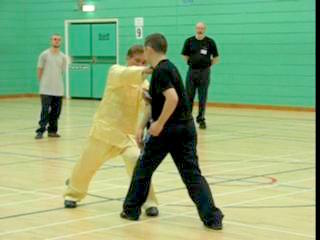
Eagle Claw Kungfu is an important style of Northern Shaolin. As its name suggests, it employs the Eagle Claw, and is famous for chin-na techniques. But there are not as many kicking techniques in Eagle Claw Kungfu as it is generally expected of a northern Shaolin style.
The Selection here is taken from the 50 Sequences of Eagle Claw Kungfu Course from 14th to 17th July 2009 at the UK Summer Camp in Brighton, England. All the 50 sequences and their combat applications as well as the applications of Eagle Claw against other martial arts were taught at the course, but only some of the lessons are shown in the video series here.
1. Where are the Eagle Claws?

An interesting feature of the 50 Sequences of Eagle Claw Kungfu is that someone watching a performance of the 50 sequences may not see any Eagle Claws shown in the sequences! One would expect to see a lot of Tiger patterns in Black Tiger Kungfu, or Crane patterns in White Crane Kungfu, but where are the Eagle Claws in Eagle Claw Kungfu, one may ask. There are there, though hidden in the open. Can you, for example, identify the Eagle Claws in the first five sequences shown in this series? The combat applications of Sequence 1 may give you some clues.
Click here to enter.
2. The Lift-Hand and the Side-Fist
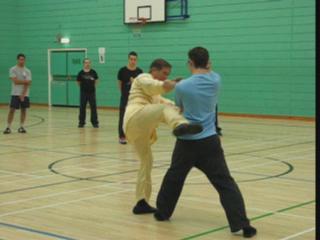
Some combat applications of Sequences 2 and 3 are shown here. The lift-hand in Sequence 2 is effective in neutralizing hand strikes. It is also effective in neutralizing kicks. In one of the videos, Grandmaster Wong executes a side-body tiger-tail kick at Nick. How would Nick neutralize it with a lift-hand? If you are skillful, the side-fist in Sequence 3 can be used against any movements. Notice how it is used to counter a whirlwind kick.
Click here to enter.
3. Linking Combat Sequences into Sets

An effective way to remember as well as to practice combat applications is to link the combat sequences into a set. This indeed was an important way how sets were composed by masters in the past. Two examples of how to compose the combat applications of Sequences 1, 2 and 3 into a set are shown. The two resultant sets are similar except a slight difference in direction in the combat application of Sequence 3.
Click here to enter.
4. Internal Force Training and Some Solo Sequences

Force training in Eagle Claw Kungfu is generally external, like gripping branches and pulling poles from the ground. There is, however, a set of Eagle Claw internal force training. This internal force training is taught to selected disciples only. Even if other students see the external forms, they may not know how the forms can develop internal force. But because internal force is an integral part of our training, we have no difficulty in understanding and appreciating it. With internal force, performance of the Eagle Claw sequences will be much enhanced.
Click here to enter.
5. Simple in Forms but Sophisticated in Applications
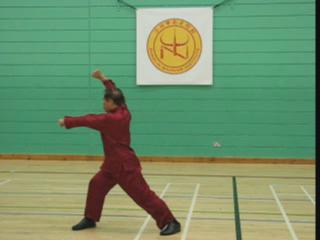
Five Eagle Claw sequences and their combat applications are shown here. Would you be able to tell their combat applications by just viewing the solo sequences? Their solo performance may look prosaic, but their applications are profound and interesting. For example, Sequence 12 which is Follow Through Punches looks straight-forward. but is sophisticated and surprising in its application.
Click here to enter.
6. Formidable Attacks that may Appear Flowery
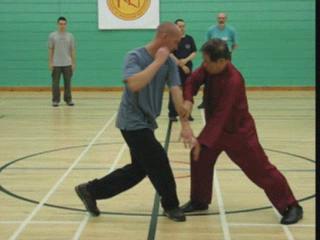
The Eagle Claw sequences shown here appear more flowery. Many people may not know how they can be used for combat. For example, what are the hands waving for in Sequence 17? Can these waving hands be used for fighting? Sequence 17 is called "Whirlwind Sweeps Leaves", and in the hands of a master he can use the sequence to attack an opponent almost irrespective of his response!
Click here to enter.
7. A Formidable Chin-Na Technique and its Counters

Eagle Claw Kungfu is famous for chin-na. A chin-na master should also know the counters to his specialized techniques so that if opponents apply these counters, he will know what to do. Moreover, he wouldn’t like to be a laughing-stock caught unprepared by opponents using his own specialized techniques on him. Hence, Eagle Claw Kungfu is also very rich in chin-na counters. A formidable chin-na technique is "chan si sau" or "spiral hand" (sometimes badly translated as "cocoon hand"). A soft counter and a hard counter against the spiral hand are shown in this series.
Click here to enter.
8. Breaking Elbows and Releasing Double Grips

What would you do if an opponent attempts to break your elbow as in Sequence 25 named Lift Elbow? An effective counter using Dark Dragon Draws Water is shown in the video. The crucial factor here is footwork. If an opponent grips your arm with his two hands, how would you release his grip? An effective counter is in Sequence 24 known as Seize Technique Pointed Fist.
Click here to enter.
9. Excellent Chin-Na Techniques for Felling and Controlling Opponents

Three interesting chin-na techniques are shown in this video series. "Stroke Eye-Brow" in Sequence 27 may also be used against an opponent’s throat. It is effective for felling an opponent. "Embracing Moon in Bosom" in Sequence 28 is poetic. Do you know how it is used in combat? Its preliminary continuous palm strikes are highly effective in the hands of a master. "Outward Grip" in Sequence 29 is excellent in controlling an opponent while striking him.
Click here to enter.
10. Hiding Eagle Claws and their Applications in the Open
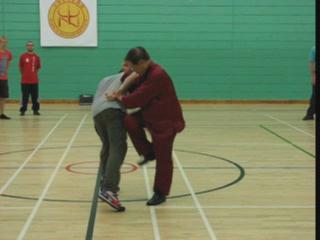
Uninitiated observers watching Eagle Claw Kungfu may not see any Eagle Claw techniques. This is because the Eagle Claws are hidden in the open. But even if you know where the Eagle Claws are, you may not know their applications. Have a look at the Eagle Claw techniques, like "Spiral Fist", "Contain Hand" and "Capture Hand", shown here. Can you guess at their combat applications?
Click here to enter.
11. Intricate Applications of Eagle Claw Techniques

An intricate secret is revealed. Suppose your opponent grips your arm with his two hands, which is not uncommon in chin-na techniques. You can release one grip by turning your wrist and the other grip by pressing on his tiger-mouth. Then you have him under control and strike him. This is the "Bottom Contain Hand" technique. Other Eagle Claw techniques, like the "Top Contain Hand", "Top Capture Hand" and "Eight-Turn Fist", are equally interesting.
Click here to enter.
12. Felling an Opponent even when Both your Arms are Locked by Him
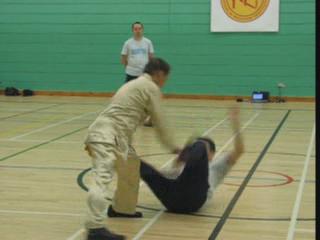
How would you lock your opponent’s both arms? You can achieve this with the "Bottom Capture Hand" technique. And if he locks your both arms and attempts to fell you, how would you counter? You can fell him instead, even when both your arms have been locked! How would you strike your opponents without fear of being counter-struck by them? "Outward Grip" and "Top Contain Hand" are two of such techniques, which are excellent against fast opponents, like Boxers.
Click here to enter.
13. Hooking, Sandwiching, Grasping and Other Eagle Claw Techniques
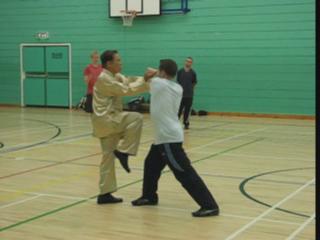
What do you think a "Hook Strike" or a "Sandwich Strike" is like? These are sophisticated techniques which often catch opponents by surprise. On the other hand, a "Grasp Strike" is a very effective technique against fast attackers, like Boxers. Eagle Claws are of course present in all these techniques, even in a seemingly unconnected technique called "Horse-Riding Punch". Nevertheless, there is a special sequence, called "Eagle Claw Grip Techniques", where the Eagle Claws are particularly obvious.
Click here to enter.
14. Supportive and Primary Attacks of Eagle Claws

The Eagle Claw is usually used as a supportive technique to grip and control an opponent while striking him. "Grasp Strike" and "Hook Strike" shown here are two of many examples. Such a tactic is extremely useful against fast opponents like Boxers. However, the Eagle Claw may sometimes be used as a primary attacking agent, as in the sequence "Eagle Claw Strong Grip Techniques", such as tearing out an opponents tendons or vital parts like the throat or groin.
Click here to enter.
15. Odd-Sounding or Poetic, but Effective for Combat

The names of some sequences like "Fell Body Technique", "Back Thrust Leg" and "Front Back Jumping Leg" may be quite odd. They are literally translated from the Chinese, because there are no suitable figurative English terms. Other names, like "Immortal Changes Shadow" and "Hide Flower in Leaves", are poetic. But regardless of whether they are odd-sounding or poetic, they are very effective for combat.
Click here to enter.
16. Eagle Claw Kungfu is a Beautiful, Complete Martial Art
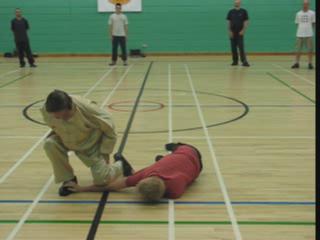
Eagle Claw Kungfu is a beautiful complete martial art. While it is famous for chin-na, there are also effective techniques for striking, kicking and felling. "Hide Flower in Leaves", for example, is a very sophisticated striking technique, but its profundity is not easily noticed. "Front Thrust Leg" and "Back Thrust Leg" are very effective for felling attack. On the other hand, a very formidable counter against kicks is found in "Front Back Jumping Leg".
Click here to enter.
17. Where are the Eagle Features in this Style?

The solo Eagle Claw Sequences 1 to 15 are reviewed here. Many people may be surprised that they do not see features of eagles, like eagles spreading their wings or flying about in the air, which they see in modern Eagle Claw wushu. They do not even see the Eagle Claw that gives this kungfu style its name. Then, do not know why it is called Eagle Claw Kungfu?
Click here to enter.
18. Applying Eagle Claw Techniques against a Boxer
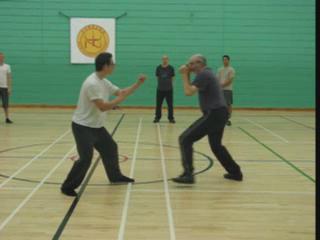
Today, irrespective of what martial arts they practice, many people fight like a Boxer. This is because Boxing is the closest to spontaneous fighting. Those who are not systematically and sufficiently trained to use a martial art for combat, fight spontaneously. Hence, if you wish to be combat efficient, it is logical that you must know how to handle a Boxer. It is quite simple -- if you know how. This video series gives many examples how you can apply Eagle Claw techniques against a Boxer.
Click here to enter.
19. Handling a Boxer's Fast Jabs and Crosses

Fighting against a Boxer is simple because his techniques are grossly limited. This does not mean that you can beat a Boxer easily. His techniques may be limited and straight-forward, but if he is skillful in using these techniques (and he usually is), he will still beat you. Nevertheless, first of all you need to know how to handle his combat techniques, like fast jabs and crosses. As these are his fundamental techniques and many martial artists fight like Boxers, this video series is very important if you wish to be combat efficient.
Click here to enter.
20. Do Not Hand your Defeat to your Opponent

Unlike in the past where combat was of a high level, the standard of sparring today is quite low. Hence, if you do not hand your defeat to your opponent, he is unlikely to defeat you. In other words, if you cover yourselves adequately to ensure safety first, not many martial artists today have the knowledge and skills to create combat situations whereby they can beat you despite your knowing how to defend against these attacks. This video series shows some examples where participants hand their defeat to their opponents. You should avoid this -- even when your opponents may not know how to exploit your set-backs.
Click here to enter.
21. Covering a Boxer Adequately and Closing the Gap if he Tries to Escape
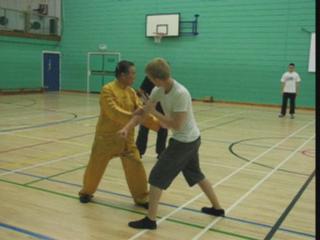
As a Boxer can bounce away quite easily and then hit you, you must not only cover him, but cover him adequately. As if he bounces away, you must close the gap immediately, giving him no opportunities to free himself so as to strike you. Stances and footwork are very important for this purpose. Gripping his elbow with your Eagle Claw is also very effective.
Click here to enter.
22. Handling a Boxer's Hooks

After handling a Boxer's jabs and crosses, we now learn to handle his hooks. There are two main ways. If the hooks are not obvious, i.e. if they appear like jabs or crosses, we can close him, treating his narrow hooks as jabs and crosses. If his hooks are large and obvious, we can intercept him. Bear in mind that a hooking attack is powerful, so your interception must be firm, preferably striking his arm at his elbow or his wrist.
Click here to enter.
23. Closing or Intercepting a Boxer's Hooks

Once you have closed or intercepted a Boxer's hook, you can apply many Eagle Claw techniques on him. You may, for example, break his arm or fell him onto the ground using "Top Lift Bottom Press", which is in Sequence 11. Or you may fell him onto the ground using "Brush Eyebrow", which is in Sequence 27. Please note that although the pattern is called "Brush Eyebrow", you may grip his throat instead as shown in the videos.
Click here to enter.
24. Handling a Boxer's Undercuts
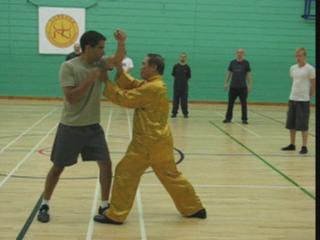
A Boxer's undercut is similar to the "skyward cannon punch" of Shaolin Kungfu. Although many people may not know how to defend against such attacks, it is actually quite easy to counter undercuts if you know how. As an undercut is powerful, it is not advisable to block it. One good counter is to strike the attacking arm. But instead of striking it head-on, it is better to strike it flowing its momentum.
Click here to enter.
25. Using Techniques for which a Boxer has No Counters
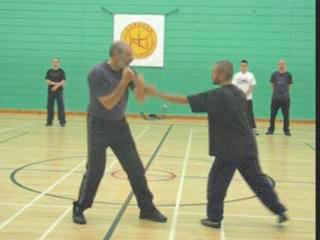
There are other effective ways to deal with a Boxer's undercuts. An effective tactic is to let him carry on a few attacks. Close his attacking arms via the out-gate (or side-gate). Then apply the coup de grace by breaking his arm, kicking him or felling him onto the ground. Have you noticed that first we give the Boxer a fighting chance, then we give him no chance, if you can successfully apply your techniques. First, we use techniques (strikes and parries) he can handle, then we use techniques (chin-na, kicks and felling) for which he has no counters in his repertoire.
Click here to enter.
26. Gripping Elbow Along with Flow

Another effective tactic to handle a Boxer's undercuts is to grip his attacking elbow following the momentum of his attack. You can then close him and strike him, or fell him onto the ground to subdue him. The videos here also show some excellent ways to fell an opponent.
Click here to enter.
27. Applying Strong Grip Techniques in Free Sparring
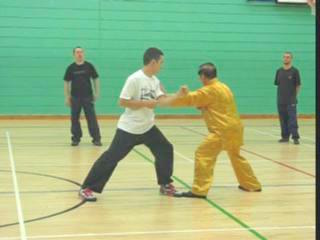
The video series here shows course participants using Eagle Claw techniques successfully in free sparring with Boxers. A favorite amongst them is "Eagle Claw Strong Grip Techniques" found in Sequence 40. You can use your stance and the opponent's attacking momentum to grip the opponent's arms more effectively.
Click here to enter.
28. Effective Tactics and Techniques against Boxers

There are some important tactics and techniques that are effective against Boxers. Firstly, it is crucial to cover a Boxer adequately so that he cannot easily strike you despite his speed. Secondly, follow his attacking momentum. Thirdly, grip his arm or elbow with your Eagle Claw. And fourthly fell him onto the ground. A Boxer has no techniques in his art to counter your felling attacks.
Click here to enter.
29. It is Technically Easier to Defeat Kick-Boxers
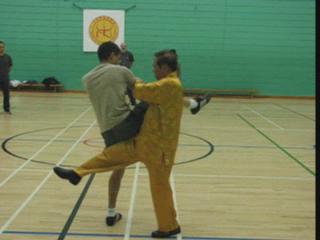
Today, irrespective of what martial arts they practice, many people fight like Boxers. Then they attempt to improve their fighting by using kicks. While it is usually true that it is harder to defend against kicks than against strikes, paradoxically this makes it easier for you to defeat them. This is because when you know the counters against strikes and kicks, it is both harder for your opponents to defend against your counters as well as easier for you to counter-attack them when they kick.
Click here to enter.
30. Two Effective Tactics against Kick-Boxers
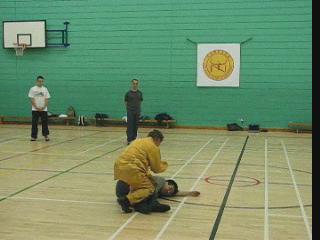
Two effective tactics against Kick-Boxers are to strike their legs when they kick, and to fell them onto the ground before they can effectively withdraw their kicking legs. It is important not to strike or block a sweeping kick. Strike a sweeping kick following its momentum, or avoid it and immediately move forward to fell the opponent when his leg has just past. Control him on the ground and apply a combat ending strike.
Click here to enter.
31. How to Fell Kick-Boxers Effectively
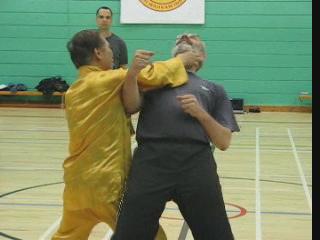
An effective tactic against Kick-Boxers is to fell them as soon as or before they place their legs on the ground after their kicks. But there are a few important points to bear in mind when you use this tactic. Firstly, you must not rush in hurriedly. Doing so would expose you to their strikes. Secondly, avoid their kicks, especially sweeping kicks, which are usually powerful. You may strike their kicking legs if you can, but make sure that your striking does not go hear-on against their kicking momentum. Then move in swiftly, taking care to cover yourself adequately, to fell him. You may also make the first move and fell him.
Click here to enter.
32. How to Handle an Attacker who Keeps Kicking You

A common mistake many people make when facing an attacker who frequently uses kicks is to move back. This will give the initiative away to the attacker, who will keep kicking you and forcing you back. How would you, then, handle an attacker who keeps kicking you? Avoid his kicks, striking his kicking leg if possible, then move in to fell him.
Click here to enter.
33. Revealing Secrets in Handling Taekwondo Exponents
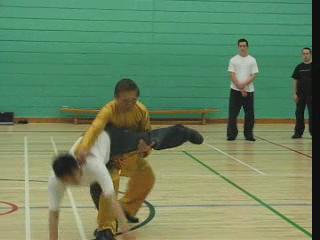
In his younger days Grandmaster had a lot of sparring with Taekwondo exponents. An effective tactic is to avoid and then strike. Instead of striking a Taekwondo exponent after his kick, you can fell him, keep him under control, then deliver a combat-ending strike.
Click here to enter.
34. Applying Chin-Na and Felling Techniques on Karate Exponents
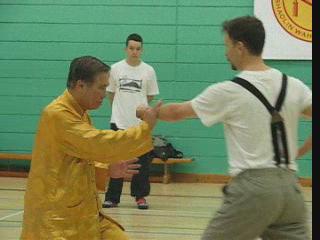
How would you handle the ferocious strikes from Karate exponents? A good tactic is to deflect their attacks, then apply chin-na or felling techniques on them. Notice that it is more advantageous to deflect their punches from the out-gate. Suitable vital points to grip when applying chin-na on Karate exponents are their wrists and elbows. You may fell them by throwing them backward or stepping on their leg.
Click here to enter.
35. Understanding Opponents is a Very Important Aspect of Combat
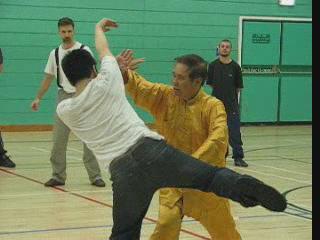
Although Kick-Boxing derives much inspiration from Muay Thai, handling a Kick-Boxer is relatively easy, whereas handling a Muay Thai fighter is difficult. It is therefore a mistake to thinking that fighting a Muay Thai fighter is the same as fighting a Kick-Boxer. Before fighting a Muay Thai fighter, or any fighter, it is highly recommended to understand how the opponent fight. Then we can work out those techniques and skills most suitable for overcoming him.
Click here to enter.
36. Deflecting Elbow and Knee Strikes of Muay Thai Fighters

Besides various types of kicks, Muay Thai fighters use their elbows and knees frequently to strike. These attacks are short-range, but are very powerful, and untrained persons often do not know how to react against these attacks. Blocking them is a grave mistake. A useful defence is to deflect the elbow and knee attacks, then counter-attack accordingly.
Click here to enter.
37. Counters against Wrestling Shoots and Lifts

Although Wrestling techniques are suicidal if there are no safety rules, they are quite common nowadays. Imagine an opponent moving in without any safety precaution and attempting to take you to the ground. If you strike your palm on his head, like what you do when you break bricks, you may kill him.
If you control your strike, he would not acknowledge it, and continue to take you to the ground. But of course we do not want to kill him. Hence you have to know how to stop him taking you to the ground, without breaking his skull, goring his eye or tearing out his throat. Two main take-down techniques in Wrestling are the shoot and the lift. Their counters are shown in the videos here.Click here to enter.
LINKS
50 Solo Sequences of Eagle Claw
50 Combat Sequences of Eagle Claw
Selection from 50 Sequences of Eagle Claw
- Where are the Eagle Claws?
- The Lift-Hand and the Side-Fist
- Linking Combat Sequences into Sets
- Internal Force Training and Some Solo Sequences
- Simple in Forms but Sophisticated in Applications
- Formidable Attacks that may Appear Flowery
- A Formidable Chin-Na Technique and its Counters
- Breaking Elbows and Releasing Double Grips
- Excellent Chin-Na Techniques for Felling and Controlling Opponents
- Hiding Eagle Claws and their Applications in the Open
- Intricate Applications of Eagle Claw Techniques
- Felling an Opponent even when Both your Arms are Locked by Him
- Hooking, Sandwiching, Grasping and Other Eagle Claw Techniques
- Supportive and Primary Attacks of Eagle Claws
- Odd-Sounding or Poetic, but Effective for Combat
- Eagle Claw Kungfu is a Beautiful, Complete Martial Art
- Where are the Eagle Features in this Style?
- Applying Eagle Claw Techniques against a Boxer
- Handling a Boxers Fast Jabs and Crosses
- Do Not Hand your Defeat to your Opponent
- Covering a Boxer Adequately and Closing the Gap if he Tries to Escape
- Handling a Boxer's Hooks
- Closing or Intercepting a Boxer's Hooks
- Handling a Boxer's Undercuts
- Using Techniques for which a Boxer has No Counters
- Gripping Elbow Along with Flow
- Applying Strong Grip Techniques in Free Sparring
- Effective Tactics and Techniques against Boxers
- It is Technically Easier to Defeat Kick-Boxers
- Two Effective Tactics against Kick-Boxers
- How to Fell Kick-Boxers Effectively
- How to Handle an Attacker who Keeps Kicking You
- Revealing Secrets in Handling Taekwondo Exponents
- Applying Chin-Na and Felling Techniques on Karate Exponents
- Understanding Opponents is a Very Important Aspect of Combat
- Deflecting Elbow and Knee Strikes of Muay Thai Fighters
- Counters against Wrestling Shoots and Lifts
Please note that only some of the lessons are shown in this video series. Those who have attended the course and wish to view the complete set of combat applications for all the 50 sequences, are requested to contact Sifu Robin Gamble for a private link.
